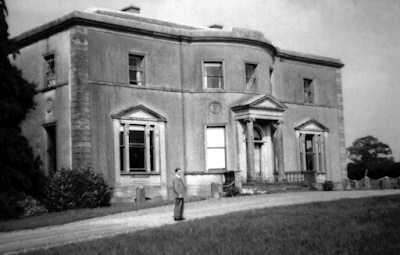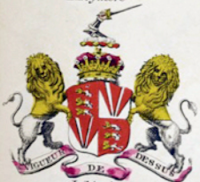THE MAHON BARONETS WERE MAJOR LANDOWNERS IN COUNTY GALWAY, WITH 8,619 ACRES
BRYAN MAHON, son of Bryan Mahon, land steward to the
Earls of Clanricarde, Lieutenant in Lord Clanricarde's Infantry Regiment, in
JAMES II's army, fought at the battle of the Boyne, 1690.
He wedded, in 1693, Ellinor, daughter of Ross Gaynor, and had issue,
James;
Peter;
ROSS, of whom hereafter;
Mary; Elizabeth; Hester; Alice; Ellinor.
Captain Mahon died in 1719.
His youngest son,
ROSS MAHON (
c1696-1767), of Ahascragh and Castlegar, County Galway, married, in 1721, Jane, daughter of Christopher Ussher, and had issue,
ROSS, his heir;
John;
Alice.
Mr Mahon, who inherited most of his brothers' fortune, was succeeded by his eldest son,
ROSS MAHON (1725-88), of Castlegar, County Galway, who espoused, in 1762, the Lady Anne Browne, only daughter of
John, 1st Earl of Altamont, and had issue,
ROSS, his heir;
John;
Henry (Rev);
James (Very Rev), Dean of Dromore;
George;
Anne; Harriette; Jane; Amelia.
Mr Mahon was succeeded by his eldest son,
ROSS MAHON (1763-1835), JP, MP for Granard, 1798-1800, Ennis, 1820, who wedded firstly, in 1786, the Lady Elizabeth Browne, second daughter of
Peter, 2nd Earl of Altamont, and had issue, three daughters,
Charlottle; Elizabeth Louisa; Anne Charlotte.
He espoused secondly, in 1805, Diana, daughter of Edward Baber, of Park Street, Grosvenor Square, and had further issue, a daughter,
Letitia Anne.
Mr Mahon married thirdly, in 1809, Mary Geraldine, daughter of the Rt Hon James FitzGerald, of Inchicronan, County Clare, by Catherine, Baroness FitzGerald and Vesey his wife, and had further issue,
ROSS, 2nd Baronet;
JAMES FITZGERALD, 3rd Baronet;
WILLIAM VESEY ROSS, 4th Baronet;
John Ross, joint founder of Guinness Mahon, 1836;
Henrietta Louisa; Georgina; Catherine Geraldine; Jane Alicia; Caroline.
Mr Mahon was created a baronet, in 1819, designated
of Castlegar, County Galway.
Sir Ross was succeeded by his eldest son,
SIR ROSS MAHON, 2nd Baronet (1811-42), ADC to the 2nd Earl de Grey, Lord Lieutenant of Ireland, who died
unmarried, and was succeeded by his brother,
SIR JAMES FITZGERALD ROSS MAHON, 3rd Baronet (1812-52), JP DL, Barrister, who died
unmarried, when the title devolved upon his brother,
THE REV SIR WILLIAM VESEY ROSS MAHON, 4th Baronet (1813-93), Rector of Rawmarsh, Yorkshire, 1844-93, who wedded Jane, daughter of the Rev Henry King, and had issue,
Ross, died in infancy, 1854;
Ross (1856-76);
WILLIAM HENRY, his successor;
John;
James Vesey (Rev);
Edward;
Gilbert;
Mary; Alice.
Sir William was succeeded by his eldest surviving son,
SIR WILLIAM HENRY MAHON, 5th Baronet (1856-1926), DSO JP DL, High Sheriff of County Galway, 1898, Major, West Yorkshire Regiment, who espoused, in 1905, Edith Augusta, daughter of
Luke, 4th Baron Clonbrock, and had issue,
William Gerald Ross (1909-10);
GEORGE EDWARD JOHN, his successor;
Luke Bryan Arthur;
Ursula Augusta Jane; Mary Edith Georgiana.
Sir William was succeeded by his eldest surviving son,
SIR GEORGE EDWARD JOHN MAHON, 6th Baronet (1911-87), who married firstly, in 1938, Audrey Evelyn, daughter of Walter Jagger, and had issue,
WILLIAM WALTER, his successor;
Timothy Gilbert;
Jane Evelyn.
He wedded secondly, in 1958, Suzanne, daughter of Thomas Donnellan, and had further issue,
Sarah Caroline.
Sir George was succeeded by his eldest son,
SIR WILLIAM WALTER MAHON, 7th Baronet (1940-), LVO, Colonel, Irish Guards, Member of the Honourable Corps of Gentlemen-at-Arms, who married, in 1968, Rosemary Jane, daughter of Lieutenant-Colonel Michael Ernest Melvill, and has issue,
JAMES WILLIAM (b 1976);
Annabel Jane; Lucy Caroline.
CASTLEGAR HOUSE, Ahascragh, County Galway, dates from
ca 1803.
It replaced two other houses in the property.
The present mansion, built for Ross Mahon, afterwards the 1st Baronet, is a square block comprising two storeys, with three at the rear, and a two-storey side elevation.
There is a curved bow in the centre of the front, with a pedimented Ionic porch.
The opulent interior is characteristic of its designer, Sir Richard Morrison.
The 5th Baronet added a service wing and back porch following his succession in 1893; thus the Doric rear hall became the new entrance hall.
 |
| Castlegar House (Image: Kellie Glynn) |
The
Irish Times wrote the following article about Castlegar in 1999:-
IT HAS STOOD there since 1803, exalting testimony to the taste and distinction of late Georgian architecture.
Castlegar is hidden away among 50 acres of gardens, parkland, woods and pasture outside the village of Ahascragh, in east Galway.
It is for sale by private treaty through Charles Smith, of Gunne's country homes division, who is quoting a guideline price of £1.5 million.
Originally, the estate was the home of the Mahons, gentry stock whose descendants linked with the Guinness family to form a land agency that eventually evolved into the Guinness Mahon merchant bank.
Sir Ross Mahon commissioned architect Richard Morrison to plan alterations to a rambling old house that existed there previously.
Rather than remodelling it, Morrison designed an entirely new building which took several years to complete.
Since 1992, Castlegar has been owned by a Frenchman with a passion for restoring old houses to their original splendour and who has spent hundreds of thousands on refurbishing it.
He is now selling it as he is unable to spend enough time there because of commitments in Paris, the US and Canada.
He is leaving one of the finest Georgian country homes in Ireland, restored with consummate care to the pristine state of its early days.
The marvel of the restoration work lies in the fact that while it has uncovered the innate beauty of the house as it was first conceived, it also has added all the appurtenances of modern living.
Castlegar has been described as the grandest of Morrison's "villas", the word villa being used in its original meaning of a country residence.
The house combines resplendent reception rooms with exceptionally comfortable family accommodation in an ambience of relaxed old-fashioned elegance.
In addition to the staff accommodation, there are six bedrooms, each with a fireplace and its own bathroom, and all providing views across the rolling plains of east Galway.
Oddly, the house has two entrances, one on the north side, the other on the south.
The south entrance, no longer used as such, opens into an oval hall with a magnificent ceiling adorned with classic floral friezes, a white marble mantelpiece, and columns flanking recessed doors that lead to the drawing-room on one side and a morning-room on the other.
Two other doors open on to the top-lit central stair hall, an elegant space where the Portland stone staircase has a simple, wrought iron balustrade and ascends to an imposing domed landing.
The oval hall, the huge drawing-room and the dining-room were radically decorated at the turn of the century with commendable taste and the present owner has attentively preserved and enhanced the adornments.
The drawing-room, which has a polished, pitch pine floor, is graced by a striking period mantelpiece with an Adam-style grate.
Classic Victorian-style predominates in the dining-room where there's a high fretted ceiling, a carved oak mantelpiece and heavy oak shutters.
A spacious billiards-room-cum-library, with a large, hand-crafted oak mantelpiece, and a beautifully appointed study are other impressive features of Castlegar.
In addition to the six bedrooms on the first floor, there is another spacious drawing-room looking across a fountain and lawns to the south.
The staff quarters are located on the second floor.
There are a further two bedrooms here as well as a kitchen, sitting-room and bathroom.
Walled gardens, a stable complex and a hard surface tennis court are spread out over several acres close to the house.
The outbuildings include a beautiful lofted cut-stone coach-house, along with four garages and three stables, plus a stable-yard that has seven loose boxes, a tack room and a further spread of farm buildings.
Beneath the house is a vaulted basement, dry and airy, with six rooms, a boiler space and a wine cellar.
I'm seeking current images of Castlegar House.




























